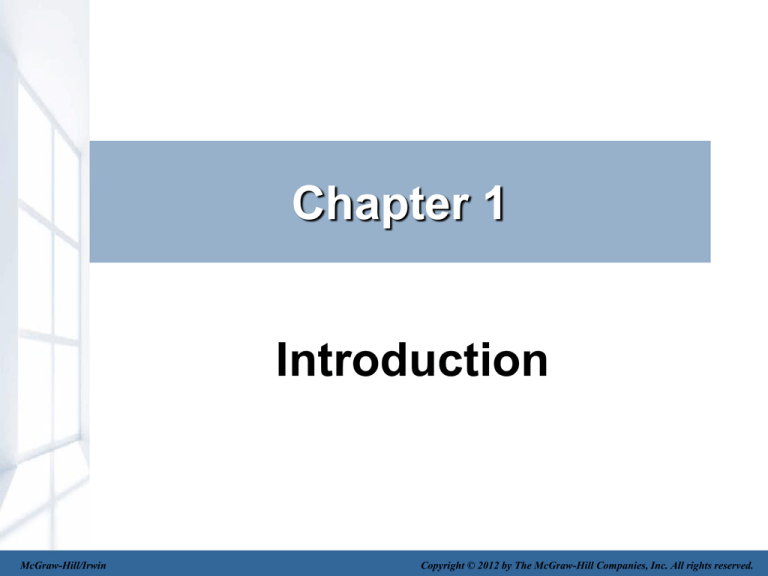
Chapter 1
Introduction
McGraw-Hill/Irwin
Copyright © 2012 by The McGraw-Hill Companies, Inc. All rights reserved.
Learning Objectives
• Understand the importance of markets.
• Identify three of the main forces
shaping today’s economy.
• Explain the debate over the role of
government in the economy.
• Define economics and discuss how
prosperity is measured
• Name some key disagreements in
economics.
1-2
Objectives of Textbook
• Tools of Economics
• Role of Market Economy
• Changing Nature of Economy
1-3
Tools of Economics
• View the world from the perspective of
an economist
• To accomplish this, need to
understand the key tools of analysis
• Some of these tools include:
– supply and demand
– elasticity
– production function
– the multiplier
1-4
Role of Market Economy
• In a market, buyers and sellers come
together to voluntarily exchange goods
and services for money.
• Market transactions are activities that
produce and exchange goods and
services for which other people are
willing to pay.
• In this text we will study how markets
work and how prices are set.
1-5
Changing Nature of Economy
• Individuals, businesses, and even
countries are subject to limits and
constraints.
• But these limits and constraints are
constantly changing.
– Goods that were once expensive are now
commonplace.
– Countries that were once poor are rapidly
growing.
1-6
Key Forces Shaping
Today’s Economy
• Need to understand forces driving
change
• Three main forces at work:
– Technological change
– Globalization
– Financial markets
1-7
Key Forces Shaping
Today’s Economy
• Technological change is an
improvement in knowledge that
increases the range of products and
services the economy can deliver.
– Examples: electricity, cars, and the Internet
• Technology creates new ways of
producing goods and services.
• Technology is the critical factor in raising
living standards.
– Technology is also a possible solution to
the energy crisis and global climate change.
1-8
Key Forces Shaping
Today’s Economy
• Globalization is the exchange of goods,
services, ideas, and people among countries.
– The world economy is becoming more global.
– Does this trend benefit the U.S. economy?
– There are many aspects to globalization,
including:
• trade in goods and services
• flow of information and movement in money
– Example: impact of China on the global economy
1-9
Key Forces Shaping
Today’s Economy
• Financial markets encompass all
those parts of the economy that have
to do with borrowing, investing, or
transferring money.
– Include the stock market, mortgages,
banks, brokerage firms, and credit cards
• Financial markets are constantly
evolving.
– Fuel economic growth by enabling
companies, individuals, and government
markets to raise money
1-10
Key Forces Shaping
Today’s Economy
• Interest rates are defined as the cost of
money and are determined in the financial
markets.
– The central bank plays a key role in determining
interest rates.
• Subprime loans given to people who did not
have enough income to qualify for ordinary
mortgages are currently a major problem in
the financial markets.
1-11
The Role of Government
• Who should guide the economy:
government, or businesses and
individuals?
– At one extreme is a centrally-planned
economy, in which all economic activities
are controlled from the top.
– At the other extreme is a laissez-faire
economy, where no government regulations
or laws exist at all.
• What is the role of competition in guiding
the economy?
1-12
The Role of Government
• Competition is the most consistent
force for growth and progress.
• The U.S. economy is the most
competitive in the world.
• There are some concerns over
excessive competition.
– Impact on job security, poverty, etc.
1-13
The Role of Government
• Government plays a large role in the
U.S. economy.
– Makes laws, regulates businesses, etc.
• Macroeconomic policy: making sure
that the economy doesn’t fall into deep
slumps where a lot of people lose their
jobs, or overheat to the point where
prices soar out of control.
– Key role in the economy played by Federal
Reserve
1-14
The Role of Government
• The role played by the government
and by private businesses differs
across countries.
• There is a global trend toward
deregulation.
– Deregulation is the process of reducing
government control over industries.
• There is a need to find a balance.
1-15
Economics Defined
• Economics is the study of how
individuals, businesses, and
governments make decisions and
make trade-offs in the face of scarce
resources.
• Role of scarcity and choice
– Limited resources
– Need to make trade-offs
– Opportunity costs
1-16
Economics Defined
• Two main areas of focus:
– Macroeconomics
• Studies the overall aggregate economy,
focusing on issues such as growth, inflation,
trade, and interest rates.
– Microeconomics
• Studies the behavior of individual units in the
economy, such as households and
businesses.
1-17
Measures of Prosperity
• Improving individual prosperity is a key
goal of economics.
• Measure prosperity by using various
indicators:
– One key measure is GDP.
• GDP is the dollar value of all the goods and
services produced by the economy.
– Other indicators of prosperity include wages,
income, and consumption.
• Use GDP to compare the level of
prosperity among countries
1-18
World’s Largest Economies
1-19
Safety Net
• Provides a measure of security for the
poor, sick, and vulnerable
– Consists of a wide array of government
programs, including Social Security,
Medicare, etc.
– Objective is to improve the lives of lowincome households
• Debate among economists as to
whether enough is being done
• Safety net programs in Europe are
more comprehensive than in U.S.
1-20
Economics –
Not an Exact Science
• There is considerable policy
disagreement among economists.
– The role that government plays in the
economy is one of the main debates.
• Some key questions include:
– How to fund Social Security and
Medicare?
– How to solve the health care problem?
– How to improve the educational system?
– What is an appropriate tax policy?
1-21
Why the Disagreement?
• Reasons for policy disagreement are
due to:
– Political agenda
– Lack of data
– Winners and losers
• The objective of this textbook is to
present both sides of the discussion.
1-22
Appendix:
Learning Objectives
• Read data from a line graph or a bar
graph.
• Plot points on a graph using data from
a table.
1-23
Appendix:
The Basics of Graphs
• Graphs have a horizontal axis (xaxis) and a vertical axis (y-axis).
• Bar and line graphs are two different
types of graphs.
• A line graph can be upward-sloping or
downward-sloping.
1-24
An Example of a Bar Graph
1-25
An Example of a Line Graph
1-26
Plotting Graphs from Data:
Population of Cleveland
1-27
Plotting Graphs from Data:
Population of Cleveland
1-28











